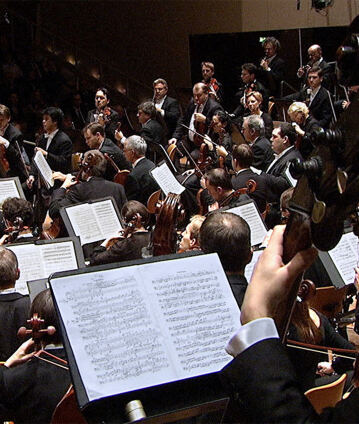Sir Simon Rattle conducts Mahler’s Symphony No. 2

In 1973, a student at the London Academy of Music persuaded his fellow students to perform Mahler’s Second Symphony under his direction. The acclaimed concert drew attention to the young conductor for the first time: Simon Rattle. In this performance, Rattle performs the work with the Berliner Philharmoniker. The programme also includes Schoenberg’s harrowing melodrama A Survivor from Warsaw.
Gustav Mahler’s Second Symphony has a particular significance in the history of the Berliner Philharmoniker: Mahler himself gave the first performance of this work with this orchestra in 1895. Afterwards, he noted contentedly, “Everything was exceedingly successful. The performers were so enthralled and gripped that they found the right expression for everything themselves.”
The symphony has also played a special role in the career of Sir Simon Rattle. When Rattle’s recording of the work with the City of Birmingham Symphony Orchestra first appeared in 1987, it was clear that a remarkable talent had arrived on the scene. The Gramophone magazine wrote at the time: “But where Simon Rattle’s interpretation is concerned, we must go into the realm of such giant Mahlerians as Walter and Klemperer, dissimilar as they were. For we are dealing here with conducting akin to genius, with insights and instincts that cannot be measured with any old yardstick.”
The symphony is a work full of power and life. Although it deals thematically with death and resurrection, it does so rather in an abstract, sublimated way. In contrast to this is the second work of the evening, Arnold Schoenberg’s A Survivor from Warsaw from 1947. Here, death is given a concrete, almost unbearable form when a narrator gives a stark eyewitness account of the massacre in the Warsaw ghetto.
© 2010 Berlin Phil Media GmbH
Related interviews
Artists
Our recommendations
- Simon Rattle conducts Mozart’s “Magic Flute”
- Simon Rattle conducts Tippett’s “A Child of Our Time”
- Simon Rattle conducts a concert “à la française”
- Mozart’s “Magic Flute” from Baden-Baden
- Kirill Petrenko conducts Beethoven’s Ninth Symphony at the Brandenburg Gate
- Simon Rattle conducts “Weltethos” by Jonathan Harvey and Hans Küng